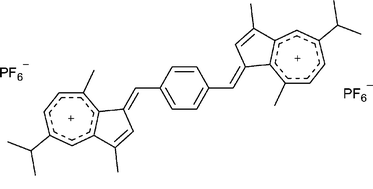Sterically crowded azulene-based dication salts as novel guests: synthesis and complexation studies with crown ethers and calixarenes in solution and in the gas phase†
Abstract
The 1,4-bis(3-guaiazulenylmethylium)benzene 1 and 1,4-bis[1-(4,6,8-trimethylazulenylmethylium)]benzene 2 dication salts were synthesized via an acid-catalyzed condensation/dehydration protocol with guaiazulene–terephthalaldehyde (2 : 1 ratio), and 4,6,8-trimethylazulene–terephthalaldehyde (2 : 1 ratio) respectively in one-pot processes. A similar condensation reaction with the parent azulene led to an insoluble oligomer that was shown by MALDI-TOF-MS to contain 1,4-bis[(diazulenyl)methylium]benzene as a repeating unit. Dication salts 1 and 2 were fully characterized by 2D NMR and NOE techniques and by electrospray-MS (ES-MS) and MALDI-TOF-MS. NMR studies confirm that the dications are best represented as bis-tropylium species. A delicate balance of electronic (inductive stabilization) and steric influence of the alkyl groups on the seven-membered ring seems to influence the chemo-/regioselectivity of the co-condensation process. NMR titration and T1 measurements established that, despite its highly crowded structure, dication 1 forms host–guest HG complexes with dibenzo-30-crown-10 (DB30C10) and dibenzo-24-crown-8 (DB24C8) in solution, but fails to complex with the smaller dibenzo-18-crown-6 (DB18C6). The corresponding HG cation–molecule cluster ions were also detected in the gas phase by ES-MS, showing the formation of both dication–crown 1 : 1 and 1 : 2 complexes. Similar complexation of dication salt 2 with DB30C10 was observed via NMR titration and T1 measurements in solution and by ES–MS in the gas phase. Although solution complexation studies (NMR titration) did not indicate stable complex formation between 1 and p-tert-butyl-methoxycalix[8]arene, their [HG]2+ and [H2G]2+ clusters were detectable by ES-MS. Solution decomplexation experiments (HG2+ → H + G2+) were performed on 1–crown complex by addition of DMSO, acetone, silver tosylate, and tropylium cation salt. Complexation of 1 with DB30C10 was also studied by microcalorimetric titration.


 Please wait while we load your content...
Please wait while we load your content...